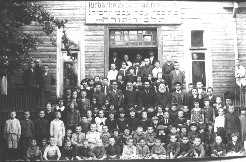Translations Funded by
the Ellis Family of Milwaukee
In memory of the Members of the Meir Eliashevitz and
Meir Krelitz Families Who Were Victims of the Shoah
Translations Funded by
the Beiles Family of Canada
In memory of the Members of the Beiles and Kizell
Families Who Were Victims of the Shoah
Translations from the
Yurburg Yizkor Book are provided
thanks to the generosity of members of the American branch of
the Krelitz Family, whose
grandmother and great grandmother was Leah Naividel
Krelitz of Yurburg.
For the full list of translated
material, click to view the Contents
of
the Yurburg Yizkor Book and
use to the hypertext to access the translated material.
Review of the English
Translation of the Yurburg Yizkor Book, By Professor
Dov Levin, Oral History Department Hebrew University
(noted expert on Lithuanian Jewry)
You do not have to be a bibliographer in
order to understand that Yizkor Books of Jewish
communities which were destroyed in the Holocaust are
still being published, but there is no doubt that their
number has decreased.
One of these books is the "Yurburg Yizkor Book",
published recently, and probably most readers were not
even aware of its existence. The main innovative
uniqueness of this book expresses itself in the quality of
its editing as well as its content. It has two parts,
written at different times, with an interval of several
decades between them. Every part embodies much assorted
material of this old and special community, due to its
location, the composition of its population and its
economic and cultural situation.
The first part of the book was published in
Jerusalem in 1991, in Hebrew, by "The Organization of
Former Residents of Yurburg in Israel" with the active
participation of, and edited by, Zevulun Poran
(Petrikansky). This translated part extends to over 2/3
(556 pages) of the English book under discussion. The
editor of this book, Joel Alpert, helped by assistant
editor Josef Rosin, was particularly careful to include
all Hebrew and Yiddish material, insisting that the
translation should be exact and that names of people and
places would be properly translated into English. It was
his intention to include general information about the
town and its Jewish community; memoirs and authentic
descriptions written by members of the community who grew
up in the town almost until the time of its destruction;
hundreds of thrilling photos of generations of families
and of the day by day life of Yurburg Jews. But what may
be of special interest for the genealogists among the
readers are the lists of names of Yurburg Jews: those who
were privileged to die naturally and be buried in the
community cemetery, as well as those who were murdered by
the Nazis and their Lithuanian neighbors from way back,
and also the few survivors.
No less interesting and thrilling is the
additional material collected and added to the second part
of the book by the industrious editor and compiler Joel
Alpert. Thanks to his energy and personal motivation to
widen the circle of more participants interested in
commemorating Yurburg Jewry, the 180 pages of the second
part include memoirs, documents and photos of former
residents of the town and its vicinity, of people who have
been living in the USA for a long time, such as Naividel,
Eliashevitz, Laden, Feinberg, Krelitz, Rosin-Hilelson,
Craine and others. This part also contains several essays
written by Israeli residents who have a special affinity
to the Yurburg community, either as a result of family
connections or because they are engaged in historical
research concerning this community: Professor Ze'ev
Bernstein from the Tel-Aviv University, Professor Dov
Levin from the Hebrew University in Jerusalem, Gita
Abramson-Bereznitsky and others.
Particular mention and praise should be
given to the B.A. thesis "Holocaust in Jurbarkas" prepared
in 1998 in Vilnius University by student Ruta Puisyte
under the guidance of Professor Meyer Shub from this
University. Apart from the historical importance of this
work it is praiseworthy to note that this Lithuanian young
lady showed a great deal of personal courage, integrity
and bravery to reveal those local Lithuanians by name, who
were the murderers of their Jewish neighbors.
It is also worthwhile mentioning the wide
ranging and moving essay "A Journey to My Past" by Fania
Hilelson-Jivotovsky.
In summary, it seems that judging from the
quality of the material included in this book, it can be
considered a small encyclopedia, which could serve as a
model for similar books.
As can be understood from the short review
above, there is no doubt that we are speaking about a
significant innovation, thanks to the courage of the
editor in presenting a book to the reader containing
facts, memories and the description of a way of life
covering a period of about a dozen generations, who were
residents of a Jewish town and who today are spread all
over the world, the common denominator being: "One
generation passes on its history and ideas to the next."

The Talmud Torah - Hebrew School in
Yurburg
(from a 1926 postcard)
According to Jack Cossid,
who emigrated from Yurburg in 1937 at age 19, the town was
almost totally Jewish. They were the middle class, the
merchants, whereas the non-Jews were mostly farmers and
lived in the countryside around the town. In 1920, the
town established a secular high school, the Gymnasium, in
which secular topics such as physics and calculus were
taught. The town had at most about 3000 residents, most of
whom were Jewish.